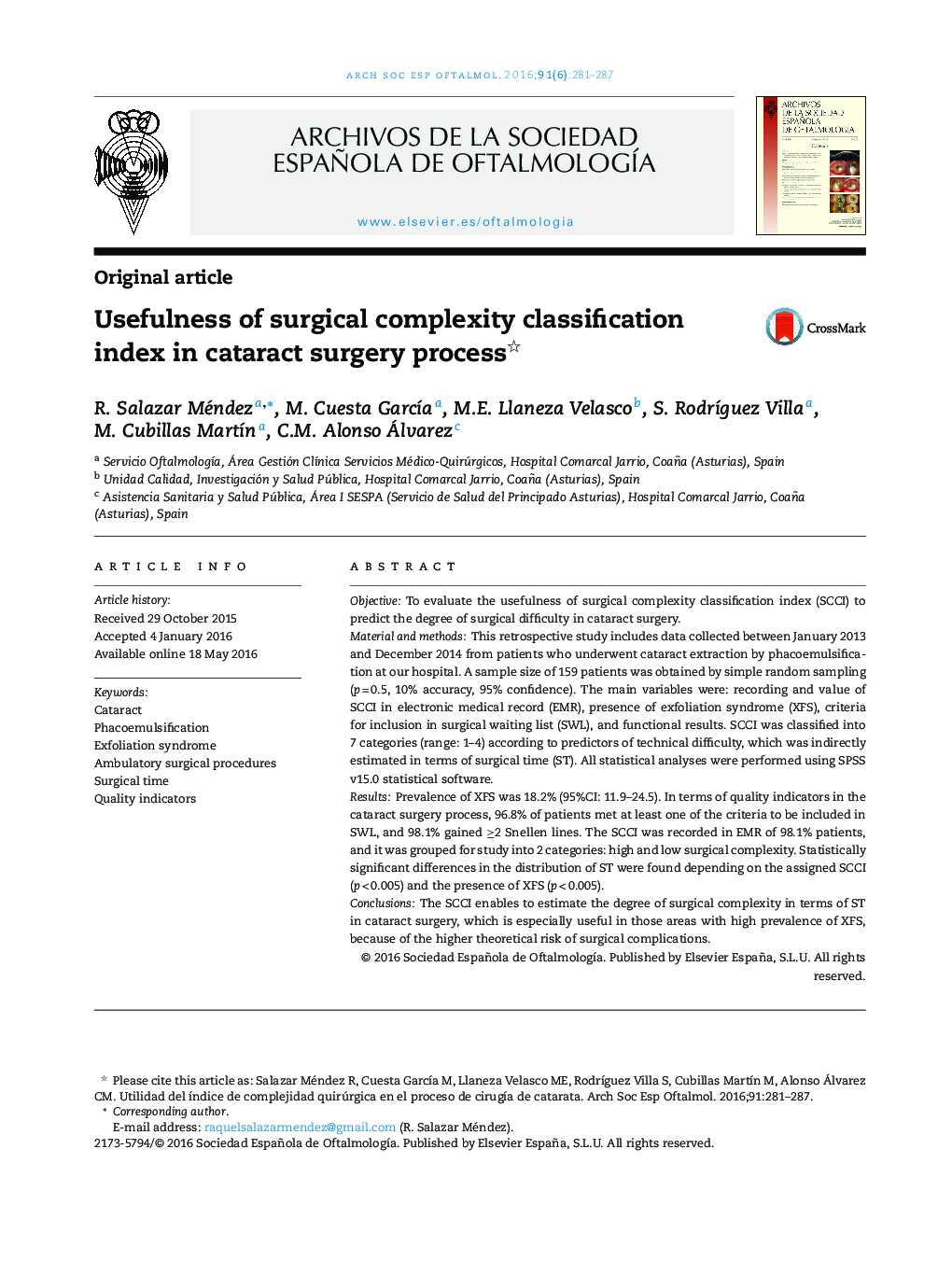| کد مقاله | کد نشریه | سال انتشار | مقاله انگلیسی | نسخه تمام متن |
|---|---|---|---|---|
| 4007948 | 1260837 | 2016 | 7 صفحه PDF | دانلود رایگان |
ObjectiveTo evaluate the usefulness of surgical complexity classification index (SCCI) to predict the degree of surgical difficulty in cataract surgery.Material and methodsThis retrospective study includes data collected between January 2013 and December 2014 from patients who underwent cataract extraction by phacoemulsification at our hospital. A sample size of 159 patients was obtained by simple random sampling (p = 0.5, 10% accuracy, 95% confidence). The main variables were: recording and value of SCCI in electronic medical record (EMR), presence of exfoliation syndrome (XFS), criteria for inclusion in surgical waiting list (SWL), and functional results. SCCI was classified into 7 categories (range: 1–4) according to predictors of technical difficulty, which was indirectly estimated in terms of surgical time (ST). All statistical analyses were performed using SPSS v15.0 statistical software.ResultsPrevalence of XFS was 18.2% (95%CI: 11.9–24.5). In terms of quality indicators in the cataract surgery process, 96.8% of patients met at least one of the criteria to be included in SWL, and 98.1% gained ≥2 Snellen lines. The SCCI was recorded in EMR of 98.1% patients, and it was grouped for study into 2 categories: high and low surgical complexity. Statistically significant differences in the distribution of ST were found depending on the assigned SCCI (p < 0.005) and the presence of XFS (p < 0.005).ConclusionsThe SCCI enables to estimate the degree of surgical complexity in terms of ST in cataract surgery, which is especially useful in those areas with high prevalence of XFS, because of the higher theoretical risk of surgical complications.
ResumenObjetivoEvaluar la utilidad del índice de complejidad quirúrgica (ICQ) como indicador de la dificultad técnica esperable en la cirugía de catarata.Material y métodosEstudio retrospectivo de intervenciones de catarata realizadas entre enero de 2013 y diciembre de 2014. Se realizó muestreo aleatorizado simple y se obtuvo un tamaño muestral representativo de 159 pacientes (p = 0,5, precisión 10%, seguridad 95%). Se analizó el registro y valour del ICQ en la historia clínica electrónica (HCE), la presencia de pseudoexfoliación (PSX), el cumplimiento de criterios de inclusión en lista de espera quirúrgica (LEQ) y los resultados funcionales. Se clasificó el ICQ en 7 categorías (rango: 1–4) según factores predictivos de dificultad técnica, que se estimó de forma indirecta a través del tiempo quirúrgico (TQ). Se utilizó el programa SPSS aplicando t de Student y chi-cuadrado para la comparación de grupos.ResultadosLa prevalencia de PSX fue del 18,2% (IC 95%: 11,9–24,5). El 96,8% de los pacientes cumplía alguno de los criterios para su inclusión en LEQ y el 98,1% experimentaron una ganancia visual final ≥2 líneas, considerados ambos indicadores de calidad del proceso de catarata. El ICQ se había registrado en la HCE del 98,1% de los pacientes, y se agrupó para el estudio en 2 categorías: alta y baja complejidad quirúrgica. Se encontraron diferencias estadísticamente significativas en la distribución del TQ en función del ICQ asignado (p < 0,005) y la presencia de PSX (p < 0,005).ConclusionesEl ICQ permite estimar la complejidad técnica de la cirugía de catarata en términos de duración de la intervención, lo que facilita la programación quirúrgica, especialmente en aquellas áreas con alta prevalencia de PSX, en las que el riesgo teórico de complicaciones es mayor.
Journal: Archivos de la Sociedad Española de Oftalmología (English Edition) - Volume 91, Issue 6, June 2016, Pages 281–287
